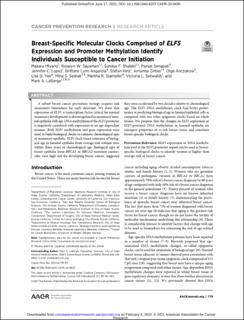Breast-Specific Molecular Clocks Comprised of ELF5 Expression and Promoter Methylation Identify Individuals Susceptible to Cancer Initiation
Miyano, Masaru; Sayaman, Rosalyn W.; Shalabi, Sundus F.; Senapati, Parijat; Lopez, Jennifer C.; Angarola, Brittany Lynn; Hinz, Stefan; Zirbes, Arrianna; Anczukow, Olga; Yee, Lisa D.; Sedrak, Mina S.; Stampfer, Martha R.; Seewaldt, Victoria; LaBarge, Mark A.
Journal article, Peer reviewed
Published version

Åpne
Permanent lenke
https://hdl.handle.net/11250/2982696Utgivelsesdato
2021Metadata
Vis full innførselSamlinger
- Department of Clinical Medicine [2043]
- Registrations from Cristin [9482]
Sammendrag
A robust breast cancer prevention strategy requires risk assessment biomarkers for early detection. We show that expression of ELF5, a transcription factor critical for normal mammary development, is downregulated in mammary luminal epithelia with age. DNA methylation of the ELF5 promoter is negatively correlated with expression in an age-dependent manner. Both ELF5 methylation and gene expression were used to build biological clocks to estimate chronological ages of mammary epithelia. ELF5 clock-based estimates of biological age in luminal epithelia from average-risk women were within three years of chronological age. Biological ages of breast epithelia from BRCA1 or BRCA2 mutation carriers, who were high risk for developing breast cancer, suggested they were accelerated by two decades relative to chronological age. The ELF5 DNA methylation clock had better performance at predicting biological age in luminal epithelial cells as compared with two other epigenetic clocks based on whole tissues. We propose that the changes in ELF5 expression or ELF5-proximal DNA methylation in luminal epithelia are emergent properties of at-risk breast tissue and constitute breast-specific biological clocks.
Prevention Relevance:
ELF5 expression or DNA methylation level at the ELF5 promoter region can be used as breast-specific biological clocks to identify women at higher than average risk of breast cancer.
